This article was published in Scientific American’s former blog network and reflects the views of the author, not necessarily those of Scientific American
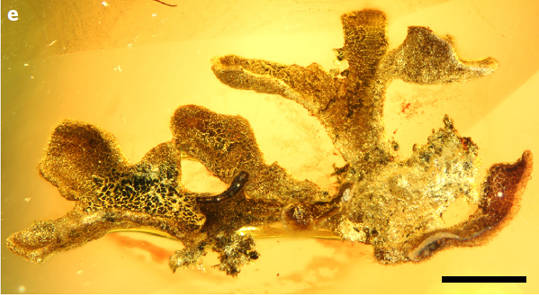
Scale bar 500 micrometers. Credit: Kaasalainen et al. 2017
Until this year, only 15 lichen fossils had ever been discovered and published. 15. Considering the ubiquity and toughness of lichens – both their leathery, decay-resistant, persistent bodies and their reputation for homesteading places so extreme that no other life forms even try to horn in – to me that number is shocking.
Fortunately, a team of German and Finnish scientists decided to take a closer look at a rich source of fossils: the Baltic and Bitterfield amber, a vast hoard of tree sap exuded by forests in northern Europe between 24 and 47 million years ago. The conifer forests of this age were for some reason extraordinarily productive and oozed an estimated 100,000 tons of sap.
On supporting science journalism
If you're enjoying this article, consider supporting our award-winning journalism by subscribing. By purchasing a subscription you are helping to ensure the future of impactful stories about the discoveries and ideas shaping our world today.
Into this future amber blundered mostly insects. A few stray plants and other miscellaneous unlucky organisms also found themselves entombed. Today, it is the largest single deposit of tree resin and fossil insects anywhere in the world – and a major source of amber for jewelry. It often washes up on beaches around the Baltic Sea from points unknown.
Lichens are found all over the planet, although they are rarely noticed by humans. Partnerships between a fungus, one or more algae, and probably some yeasts and resident bacteria and archaea, lichens have been extraordinarily successful in colonizing harsh frontiers like tree bark, bare rock, and bone-dry needle litter. This partnership has been so successful that it now appears, based on DNA evidence, that it has evolved no less than 15 times.
It comes as no surprise, then, that lichens are abundant where other life forms struggle, like within the Arctic Circle or within many deserts. But lichens are also abundant in many forests (with the notable exception of tropical rainforest), and they seem to be most diverse and abundant in those which are also humid.
Considering lichens’ tendency to grow near sap-exuding conifers, their relative absence from the fossil record is all the more surprising. Apparently, these scientists had precisely the same thought and set about taking a closer look at hundreds of Baltic amber specimens. Of the 15 unambiguous lichen fossils that had been described before, nine came from that deposit (the oldest known lichen fossil dates from the Early Devonian, over 400 million years ago).
At the end of their search, published in April in Nature Plants, they concluded that the lack of lichen fossils was only for lack of looking: Baltic amber is full of them. They found 152 new lichen fossils in 122 amber specimens, multiplying the number of known lichen fossils more than ten-fold.
Among these fossils are representatives of nearly all the major lichen growth forms: foliose (leafy), fruticose (shrubby), crustose (crusty), and squamulose (in between leafy and crusty).
What is striking about these lichens is just how similar they appear to those living today, despite a separation of tens of millions of years.
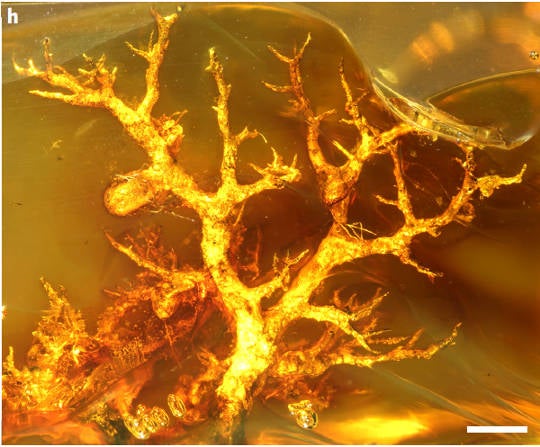
A shrubby fruticose lichen. Similar lichens today include the common reindeer lichen. Scale bar 1 mm. Credit: Kaasalainen et al. 2017
Scanning electron micrographs of cross sections of lichen show their algal cells are roughly the same size and shape as those seen today.
.jpg?w=541)
Dense cortex (surface layer) and more loosely woven medulla stuffing the lichen. Credit: Kaasalainen et al. 2017
The medulla, the loose stuffing of the lichen, which plays and aids in gas exchange, either fills the lichen entirely or surrounds a hollow core that also helps gases suffuse its body.
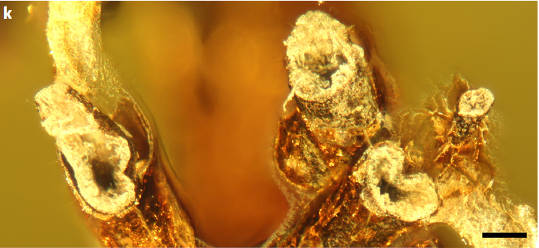
A lichen with hollow lobes surrounded by medulla and cortex. Scale bar 100 micrometers. Credit: Kaasalainen et al. 2017
The spongiostratum is, as its name implies, a sponge layer used for water storage.
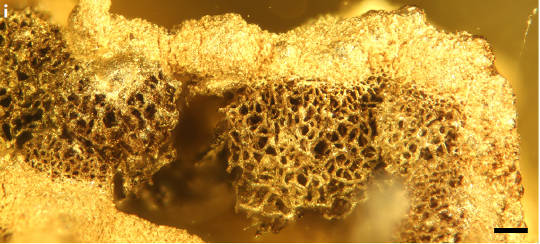
Scale bar: 100 micrometers. Credit: Kaasalainen et al. 2017
Openings in the lichen, root-like structures called rhizines, cortical hairs, and reproductive structures all appear more or less like modern equivalents. In addition to the fungal structures seen below, asexual reproductive structures called soralia, isidia, and lobules -- basically places where tangles of fungus and alga break off to spread the lichen -- were all also present.
This is a stalked apothecium, the reproductive structure of the fungus part of the lichen. On top of the stalk is a collection of sacs containing the fungus's spores.
.jpg?w=381)
Scale bar 100 micrometers. Credit: Kaasalainen et al. 2017
Here's another stalked apothecium. This one is my favorite. It looks like one of those high speed images of a water drop going plonk. Or perhaps some sort of alien impact crater/golf tee.
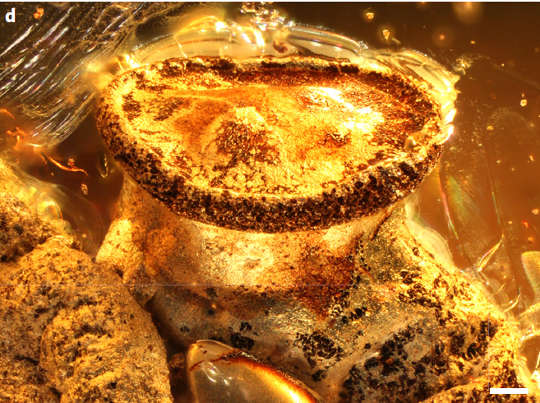
Stalked apothecium of a foliose (leafy) lichen. Scale bar 200 micrometers. Credit: Kaasalainen et al. 2017
Reference
Kaasalainen, Ulla, Alexander R. Schmidt, and Jouko Rikkinen. "Diversity and ecological adaptations in Palaeogene lichens." Nature plants 3 (2017): 17049.